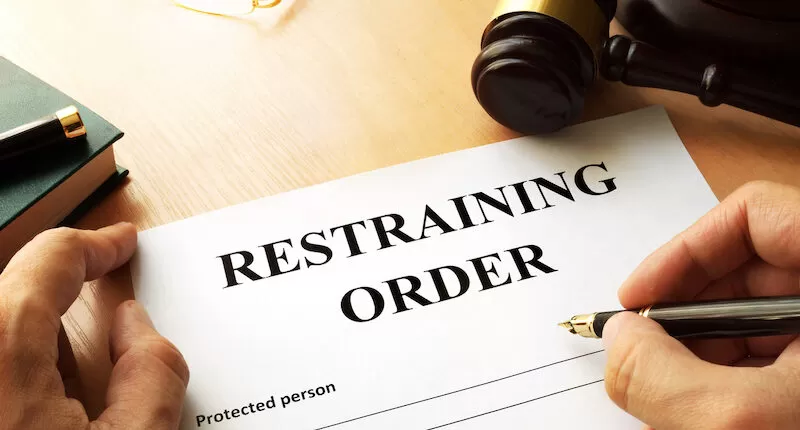The Types of Restraining Orders in California
The laws surrounding restraining orders vary from state to state, and California is no exception.
Read on to familiarize yourself with the types of restraining orders.
Introduction
Restraining orders (sometimes called orders of protection) are legal documents that protect you from someone else’s actions. Because there are many situations where this protection is necessary, the state of California offers a few different types of restraining orders.
These orders are specific to a particular person and a certain action (or actions) they cannot take without violating the order and leading to potentially serious consequences.
How to Obtain a Restraining Order
You could seek many different types of restraining orders, but they all require you to complete the designated forms provided by the court to request a specific type of restraining order. This needs to be done by the victim.
These forms are then filed with the court and officially served on the abuser (or perpetrator you seek protection from). A judge will provide a court date, and both parties must appear to present their case.
Victims seeking an order of protection should retain a lawyer to get the best outcome when debating the types of restraining orders.
Domestic Violence Restraining Order
A domestic violence restraining order is more common than you might imagine. These orders protect a victim from someone abusive. This perpetrator will be a spouse, significant other, or someone with whom there has been romantic involvement. These orders also protect against abusive family members, such as those who are:
- Dating
- An ex
- Married
- Divorced or separated
- Domestic partners
- Cohabitation
- Parents
- Close relatives
The victim is responsible for proving that they fear the abuser and that the abuser has harmed them with abuse, threats, sexual assault, stalking, or severe harassment.
Elder or Dependent Adult Abuse Restraining Order
The elderly and other dependent adults rely on their caretakers, and there are laws in place in California to protect them. Unfortunately, they all too often become easy targets for abuse. And it can appear in many different forms, including:
- Physical abuse
- Neglect
- Abandonment
- Financial abuse
Mentally or physically harming an elderly or dependent adult – or not meeting their basic needs – can leave caregivers in hot water and may cause a restraining order. Remember, the victim must be at least 65 years of age or an adult who is disabled and dependent on their caregiver to seek this protection.
These individuals cannot often advocate for themselves, so it is always a good idea to get an attorney involved to see the case through to a successful outcome.
Civil Harassment Restraining Order
Civil harassment restraining orders or those put in place to protect a victim from a perpetrator. Like a domestic violence restraining order, it offers protection against threats of violence, violence, harassment, stalking, etc. But it allows victims to file this order against others that are close family or romantic partners. For instance, you can file a civil harassment restraining order against:
- Extended family members
- Friends
- Neighbors
- Roommates
These situations are frequent and often benefit from an attorney’s help. This is especially helpful since getting into the specifics of each case to prove the need is crucial.
Workplace Violence Restraining Order
Workplace violence is growing in the number of yearly incidents – and even more, cases go unreported. The state of California has a workplace violence restraining order in place that is available to employers who want to protect an employee.
Notice that we said employers take out these orders on behalf of their employees. This is often the case when the employee has reported and documented situations involving stalking, severe harassment, abuse, or credible threats of violence.
Criminal Protective Order
A criminal protective order is slightly different than the other restraining orders but still worth mentioning. It orders the defendant in the case to stay away from the victim while the case is still ongoing. The court often issues this in a pending criminal case. Often, these offer protection for up to 3 years after a judge disposes of the case.
How Long Do Restraining Orders Last?
Once you get a restraining order in place, you may finally be able to breathe a sigh of relief. But for how long?
Different types of orders vary significantly in how long they last. In some cases, you may only have a couple of days of protection, whereas, in others, you may have a couple of years.
An emergency protective order needs to be issued immediately. This is a high-risk situation, and it goes into effect right away. Law enforcement officers can request this from a judge, which buys the victim a week of protection – and time to file for a temporary restraining order.
Temporary restraining orders are those put in place when immediate protection is needed – and it can’t wait for the case to be heard. These often last about 20 to 25 days, and a court date will be set for each side to present their case. The judge has the final say as to whether they will issue a permanent restraining order.
Finally, a permanent restraining order gives you the most extended protection. Though just how long that time is will be based on the specifics of the case and everything involved. Often, the greater the threat, the longer the permanent order of protection will be in place – and some of them can last years.
Seeking Legal Representation
It must be severe and concerning if something has happened in your life that has you at the point where you must file for a restraining order. Don’t leave your safety and security to chance. Instead, hire an experienced family lawyer to ensure you have the best chance of feeling protected.
The state of California has laws in place to protect those who are in vulnerable situations. An attorney can help you take advantage of them.
Are you in search for a certified attorney to represent you?
Let us help you find one today!


